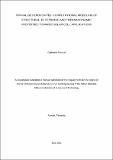Tin halide perovskites: computational modeling of structural, electronic and thermodynamic properties towards solar cell applications
Abstract
In the photovoltaic field, significant attention has been drawn to lead organo-halide
perovskite materials because of their higher ability to convert sun energy to electricity and
relatively simple process of fabrication as compared to silicon materials. Among the issues
which hinder the lead perovskites solar cells (PSCs) application, are lead toxicity and
instability of the PSCs in presence of moisture and light. The tin perovskites are thought over
as the foremost fitting substitute due to their comparable chemical nature and high-power
conversion efficiency. In this work, the methylammonium tin iodide CH3NH3SnI3 (MASnI3)
and guanidinium tin halides C(NH2)3SnX3 (GUASnX3), X = Cl, Br, I, are considered; the
electronic, structural as well as thermodynamic properties of the perovskites’ orthorhombic
phase (O-phase) have been investigated using various theoretical DFT approaches. For the
MASnI3, a direct band gap has been proved; in gamma symmetrical point of the band
structure, the band gap value Eg is computed using three different exchange-correlation (XC)
functionals: LDA 0.46 eV, PBEsol 0.98 eV and for PBE 1.12 eV; the best result has been
obtained with the PBE which follows from the comparison of the computed Eg and lattice
parameters with available experimental data. The enthalpy of the decomposition reaction of
the MASnI3 into the solid-state materials, SnI2 and CH3NH3I, with reaction enthalpy, ΔrH°(0
K) = 37 kJ mol–1
, and enthalpy of formation ΔfH°(CH3NH3SnI3, 0 K) = –390 kJ mol–1
, have
been evaluated showing the stability of the O-phase perovskite at low temperature. For the
guanidinium-tin perovskites GUASnX3, the lattice parameters are optimized using the GGA PBE functional. Computations of the materials’ band structures was carried out, and band
gaps at the gamma symmetry points were obtained: 3.00, 2.47 and 1.78 eV for the
C(NH2)3SnCl3, C(NH2)3SnBr3 and C(NH2)3SnI3, respectively. The projected state densities
are visualized, and the s-and p-states contribution of the halogens and tin to valence and
conduction bands of the perovskites assessed. For the GUASnX3 compounds, the
thermodynamic stability to different decomposition routes is examined, the standard
enthalpies of formation are obtained: –673 (GUASnCl3), –541 (GUASnBr3), and –401 kJ
mol–1
(GUASnI3). The interface between the hole transport material Cu2O and perovskite
MASnI3 has been built and analyzed; the predicted binding energy shows strong binding
between the two layers.

